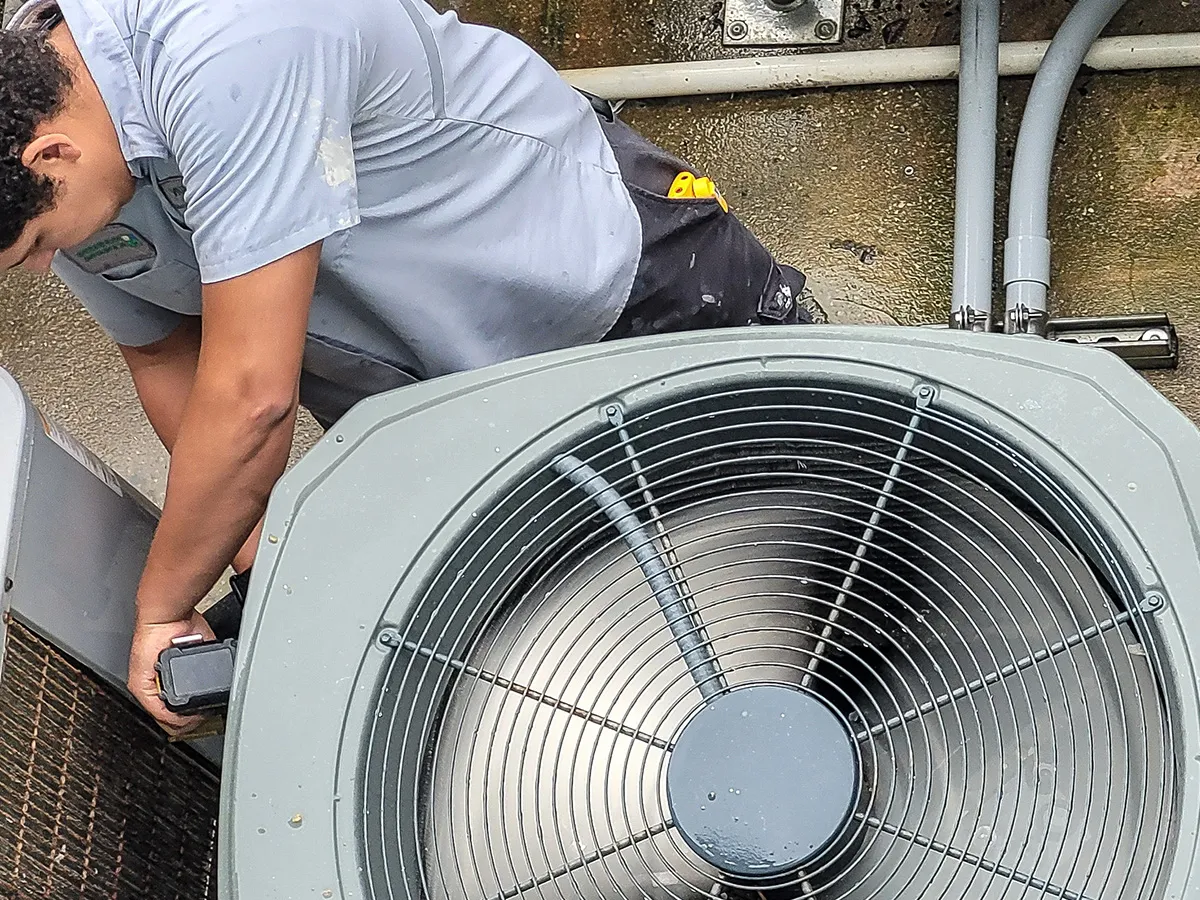In case you need help
Rawal Devices offers not merely a product for sale, but a wide range of solutions for the challenges often faced by mechanical engineers, air conditioning contractors, and facilities owners and operators. With years of experience supporting air conditioning installations, our engineers and customer support personnel can provide solutions that help air conditioning and heat pump systems better suit their applications.
Rawal Devices takes a holistic approach to environmental comfort conditioning. We consider many factors that impact system performance, such as system size and staging, load parameters, current operating issues (including duty cycle and humidity levels), as well as controls integration.
With an exceptional record of solving a wide range of system and application problems, Rawal Devices brings the resources necessary to help evaluate and resolve any issues you may encounter. While many applications will benefit from the addition of the APR Control, there are times when we can solve system and operational problems through servicing, without the need for a Rawal device.
FAQs
- Application
-
As the heat content of return air drops, the suction pressure drops opening the APR Control. The compressor discharge gas gets sent into the desuperheating chamber then back to the suction line. A liquid injection valve mixes liquid with the discharge gas (in the desuperheating chamber) when the mixed gas temperature rises to 60F. The APR Control derates the evaporator coil capacity extending the run time while keeping the active portion of the coil at a constant temperature (below dewpoint) thereby dehumidifying during the extended run period. Watch the video below for more information.
-
Before you call Rawal Devices, we will need the following basic information; including equipment information, equipment cycle times, general building and space information, what you believe is possibly causing the humidity issue, and outdoor climate. It is likely that the APR Control could provide a simple and cost effective solution.
-
It is inevitable that an HVAC system is oversized by design. Almost all HVAC design parameters calculate the cooling load expected on the machine on the hottest day of the year, full building occupancy, all interior equipment in operation (lights, computers, printers, process machinery, etc.).
The reality is, these conditions will only occur less than 10% of the year, with even a smaller percentage being above design conditions. Leaving the majority of the time well under design conditions. As a result, the equipment selected is most likely oversized to accommodate the extremes (at or above design conditions). Now this leaves a piece of equipment that will be oversized for most of the year.
Oversized equipment will lead to component abuse, short-cycling, high humidity, and generally uncomfortable space conditions. With the APR Control’s ability to lower the capacity to match the actual space conditions, all these symptoms can be eliminated.
-
Essentially, the APR Control operates as an external modulating compressor capacity unloader. As the heat content of return air drops, so does the system’s suction pressure. The APR Control senses that drop in suction pressure, opening the APR Control to maintain a suction pressure setpoint.
When the APR Control begins to function (modulates) to maintain suction pressure setpoint, it will start diverting discharge gas from the compressor through our CRR valve. The diverted gas is sent into our Desuperheating chamber, where it is cooled down and sent back into the compressor via the suction line as a cooler gas. If the Desuperheating chamber can’t cool the gas down enough, due to a high rate of capacity modulation, the liquid injection valves will inject a tiny amount of liquid to maintain no more than a 20(degree) superheat at the compressor.
This diversion of mass flow around the compressor varies the amount of refrigerant through the TXV, evaporator, and condenser. This varied amount of refrigerant allows the system to match the capacity of refrigeration to the actual heat load entering the system.
By matching the capacity to the load, the APR Control can extend the run time of the compressor, proven to be very effective in dehumidification. This load matching ability serves as a benefit for VAV systems, MUA, as well as various other systems and applications.
-
The APR Control helps or solves high humidity issues by matching the system’s capacity to the actual cooling load in the space. Matching capacity results in longer runtimes of the compressor, which has been proven to significantly lower humidity.
-
Often systems will short cycle either as a result of being oversized from the beginning, or simply because the load varies too much during the air conditioning operating season. The APR Control will often be employed to help reduce system capacity and extend runtimes.
-
APR Control will keep the suction pressure from falling to prevent coil freezing, compressor floodback, short cycling, and low discharge air temperatures. By eliminating these symptoms, you can extend your compressor lifecycle.
-
The APR Control can protect against the problems related to clogged filters, which will likely cause airflow across the evaporator coil to be reduced causing a drop in suction pressure which will eventually result in coil frosting. The APR will maintain suction pressure by modulating refrigerant flow reducing capacity at the evaporator.
-
High humidity conditions, in spaces serviced by direct expansion equipment can result from short cycling conditions, or as a result of too much cooling capacity compared to load. Studies have found that if a short cycling condition exists, and the evaporator coil is not kept “active” for a long enough runtime period, the coil may start to load with moisture, but runtime could be too short for that moisture to fall to the drain pan and down the drain…which is officially when dehumidification is completed, all other conditions may result in the moisture re-evaporating back into the air stream and into the space!
-
Undersized ductwork will lead to reduced airflow across the evaporator coil resulting in an extreme suction pressure drop. The APR reduces refrigerant flow to eliminate the chance of coil freezing as a result of low evaporator temperature. The APR Control will protect the refrigeration circuit from ultimately failing. In some situations, correcting the ductwork can be unfeasible even though it will provide a better/correct system. The APR Control will protect the circuit and allow the unit to function within the duct design limitations.
-
Mismatched equipment such as improper fan size, or undersized evaporator coils can be relieved with the addition of the APR Control. Cost or job design may prohibit the ability to replace the equipment fan/evaporator. The addition of the APR Control will manage refrigerant flow to better match the output of the condenser section with the capacity of the evaporator/fan coil.
-
Liquid slugging can result in damage to the compressor! The APR Control prevents or eliminates liquid slugging or compressor floodback from occurring by varies the cooling capacity of the evaporator coil by modulating refrigerant flow. During low load or non-design day conditions, when floodback or slugging is likely to occur, the APR Control will only allow enough refrigerant into the coil that can be fully evaporated.
During mechanical failures, like a broken TXV or loose fan belt, the APR Control diverts vapor into the suction line so that liquid refrigerant never reaches the compressor!
-
As the APR Control can help match system capacity, it is, by extension, minimizing extremes in space temperature and relative humidity. By simply stabilizing space conditions with the APR
Control, a significant number of “nuisance calls” can be eliminated. Also, by reducing the wear and tear related to short cycling, coil frosting and liquid slugging, it is likely that adding the APR Control to the circuit will reduce downtime over the life of the system.
-
When dealing with high percentage outside air systems, it comes down to matching the capacity of the compressor(s) to the varied entering air conditions. The APR Control’s ability to load match will keep the compressor active despite the varied entering air conditions. This load matching ability of an APR Control enhanced system will keep discharge air temperature consistent, the discharge air below desired space dew point, as well as preventing compressor abuse from rapid cycling or floodback. These are the conditions that historically have plagued DX systems in high percentage outdoor air applications.
- Installation
-
When installing the APR Control, you will need the following additional materials:
- “T’s” for each of the APR Control connections to the system suction line, liquid line, discharge line and the external equalizer line where necessary.
- Isolation Ball Valves are required for each connection.
- There will be a small amount of piping needed
- Insulation for the sensing bulbs only
- Mounting hardware
For more comprehensive details of what is needed, please contact us or see our installation video.
-
Yes, the APR Control must be mounted vertically upon installation. Vibration resulting from the operation of the compressor could put strains on the piping and control. A simple mount to either the cabinet or a stand is all that is needed.
See our installation video.
-
Yes, the APR Control can only be mounted vertically, in such a way that the Schrader/access valve is located down and the mixed gas discharge to the suction outlet up. ANY OTHER POSITION OR ORIENTATION IS UNACCEPTABLE AND WILL LEAD TO SYSTEM PROBLEMS AND LIKELY DAMAGE.
-
No. It is preferred to install the APR inside the unit housing, but it is also ideal to have access to the control. If exterior installation is preferred, make sure there is limited access to the unit from the general public.
-
No, the chamber holds no charge. If you have any questions or concerns, please call our Technical Support team!
-
Much like a TXV or any other device added to the refrigerant system, you need to provide protection from excessive heat when soldering or brazing the APR Control.
-
We recommend Harris Products Stay-Silv 15 or equivalent 15% silver alloy.
-
Yes, the APR should always be securely mounted in the vertical position!
You also want to avoid creating traps while installing field piping. Don’t want these lines filling up when APR not active. Be sure to follow standard piping best practices.
Every job is unique, if you have any concerns field free to call us. Also check out our installation video.
-
Yes for every APR Control, there will be at least 3 connections that need to be made (some have 4). All piping connection will be made within the compressor compartment of the condensing section/unit.
The Compression Ratio Reduction Valve (CRR Valve) should be piped into the compressor discharge line, after the compressor before the condenser.
The Mixed Gas Discharge line of the APR should be piped into the suction line after the evaporator and towards the inlet of the compressor.
The liquid line….
-
The Sensing Bulbs connected to the APR Control valves will be installed between the Tee connecting the APR to the suction line and the compressor. These bulbs must be strapped to the suction line and properly insulated. Equalizer Lines (where the APR Control has such connections) will tap into the suction line between the suction line Tee and the compressor.
-
Yes, this is as critical as any step in the installation of the APR control. The insulation needs to be properly installed and completely covering the APR Control valve bulbs. The insulation needs to be adequate to protect the bulb from the ambient temperature.
-
No, the APR Control must not be insulated as this would reduce the effectiveness of the APR Control’s operation. The heat is shed through the wall of the desuperheating chamber.
-
The APR Control is designed to modulate based on entering air conditions at the evaporator. If your system is going to be running in low ambient conditions, please refer to the manufacturer’s recommended low ambient kit. The APR Control is NOT a low ambient control.
- Selection
-
Each APR Control needs to be sized and selected by Rawal Devices’ Engineers based on your specific system and application.
The APR Control is not a one size fits all solution. We select and size each individual APR Control that leave our factory.
In order for our team to properly size and select the APR Control(s) that is best for your system, we will need to know the following information:
- Refrigerant Type
- Total Systems capacity in tons
- Capacity of the lead stage in tons
- The compressor and circuiting configuration Example: Dual stage/dual circuit (two independently controlled circuits) Example: Dual stage/single circuit (two independently controlled stages on a single circuit)
- Is there a lead-lag control (does first stage on rotate between compressors/circuits)?
- Evaporator Coil Configuration
- Single circuit
- Dual circuit intertwined
- Dual circuit split face
- Or Other Configuration
- Split or Package System
- Split systems will require additional information, including:
- Suction line size (inches OD)
- Line size of ANY AND ALL suction risers (inches OD)
- Total suction line length
- Total length of ALL suction risers
-
We specifically size and select APR Controls to provide the maximum modulation at the evaporator while ensuring proper oil return to the compressor. All forms of modulation that change the velocity of the suction gas have this concern. We ensure this is not an issue by sizing our APR control to maintain above the minimum velocity in the suction lines necessary for proper oil return.
-
The APR Controls are classified by refrigerant and the maximum amount of modulation. Thus an APR-410-1 gives 1.5 tons of modulation on an R-410A system. Please note that the capacity listed on the APR is the modulation capacity and should NEVER match the total system capacity. 100% modulation is NEVER acceptable.
Example: a 3.5 ton system could not use the APR-410-3 (3.5 tons of modulation).
-
The suction line size and more importantly is the riser size will determine if the oil will return. ANYTIME the suction line creates a trap or has a vertical rise (in direction of gas flow) there needs to be both velocity and volume to carry the oil up. WE ENSURE THIS IS ADDRESSED WITH PROPER SELECTION AND SIZING.
-
You will need to know total tonnage of the unit. Then the tonnage of the circuit and in particular the lead circuit (referred to as: First On/Last Off circuit). Then we need to know the tonnage of the lead compressor stage. Only one APR Control can be installed per circuit. In most cases, only one APR is needed per system. However, there are cases where an APR Control on each circuit might be beneficial…split face evaporator coils, MUA, VAV, for example.
-
In most applications the installation of the APR on the lead circuit is enough. When both stages are operating, a drop in suction pressure will modulate the lead circuit. When the second stage shuts off, the APR Control will continue to modulate. In some applications the use of an APR on all circuits may be beneficial, please consult our Technical Support Team for assistance.
-
If lead-lag must be used, then an APR must be installed on each circuit to maintain modulation during low load conditions.
-
The APR Control provides continuous capacity modulation on direct expansion air conditioning and refrigeration systems. Contractors, Distributors, and Engineers referred to the APR Control as hot gas bypass because it was the easiest way to remember and explain application use. However, the APR Control is NOT hot gas bypass! The APR Control unloads the compressor and hot gas bypass loads the evaporator.
-
Yes.
- Start-Up & Adjustment
-
Charging Unit after APR Control Installation.
After properly installing an APR Control a unit should be charged to the factory recommended specifications, the installation of the APR Control does not require additional refrigerant. During the charging process in order to maintain accurate pressure readings the manual shut off valves at the APR Control connection points should remain closed, this will prevent the APR Control from attempting to modulate during the charging process.
Start-up Procedure
With the manual shut off valves at the APR Control connections closed, follow equipment manufacturer’s start up procedures to ensure the unit is operating properly. Once it is determined the unit is operating properly, open the manual shut off valves to bring the APR Control into the circuit.
In order to test operation of the APR Control there must be a reduction in suction pressure. To simulate this process restrict the airflow across the evaporator coil just enough to lower the suction pressure below the desired suction pressure setpoint of the APR Control. At this point the APR Control will attempt to stabilize the suction pressure.
-
The APR Control is shipped from the Factory set for approximately 40 degrees F. evaporator coil temperature, or to start opening at 118psi (in an R-410A system). We have found this to be an excellent setpoint for most applications, and will not require adjusting the APR Control.
However, every job, system, and application is unique. Our rule of thumb is to allow the APR Control to provide maximum modulation before compressor termination. If the runtime is inadequate or low load operation does not cause suction pressure to fall low enough, you may need to adjust the APR Control Compressor Ratio Reduction Valve (CRR Valve).
Please call Rawal Devices Engineer’s (800-727-6447) at the factory prior to attempting any adjustment.
-
No, YOU WILL NEVER NEED TO ADJUST THE INJECTION VALVE. If you believe there is any need to adjust the liquid injection valve, reach out to our team.
Adjusting the liquid injection valve without consultation with Rawal Devices Senior Technical Engineer will void warranty.
Please call Rawal Devices Engineer’s (800-727-6447) prior to attempting any adjustment!
- Troubleshooting
-
The APR Control must be isolated during system troubleshooting. Otherwise, you will not be able to judge what the unit is doing when an APR control is operating. You will need to isolate the control from the system with either a ball valve or solenoid valve (with manual stem) in the suction line between the outlet of the control and the “T” on the suction line. It is imperative that isolation ball valves be installed on all connections to the APR Control device. Without these isolation valves the APR Control can mask several types of issues that would otherwise be easily diagnosed.
-
The APR Control is shipped from the Factory set for approximately 40 degrees F. evaporator coil temperature, or to start opening at 118psi (in an R-410A system). We have found this to be an excellent setpoint for most applications, and will not require adjusting the APR Control.
However, every job, system, and application is unique. Our rule of thumb is to allow the APR Control to provide maximum modulation before compressor termination. If the runtime is inadequate or low load operation does not cause suction pressure to fall low enough, you may need to adjust the APR Control Compressor Ratio Reduction Valve (CRR Valve).
Please call Rawal Devices Engineer’s (800-727-6447) at the factory prior to attempting any adjustment.
-
When we receive this phone call at Rawal Devices, 98% of the time this is caused by a leak in the system or the system having a low charge. We recommend isolating the APR Control by closing all of the ball valves, and diagnosing the system per manufacturer’s recommendations.
The other possibility is that the evaporator is in a constant low load condition where modulation is needed. For example, low airflow (below 375 cfm/ton), dirty filters, loose belt, extremely low room setpoint (below 68 deg), high percentage outdoor air during low ambient conditions, etc. In these conditions it is beneficial for the APR Control to operate to prevent floodback and icing.
-
No. The APR Control when active will reduce the head pressure and increase subcooling. In the 30+ years of Rawal Devices operating, there has never been an instance where the APR Control increased head pressure.
-
Diagnosing the system without the isolation ball valves, is extremely time consuming and difficult. Evacuating the system, installing the ball valves, and recharging may be more efficient with your time and eventual accuracy of your diagnosis.
If installing ball valves is not feasible or possible, then consult with our Senior Technical Engineer by calling Rawal Devices (800) 727 – 6447.
If you are on the job site dealing with this issue, please let our team know and you will speak with a real person immediately to solve your issue.
Here are several ways to contact us:
Need technical support?
Call our Tech Support team at
877-574-3071 or email us at techsupport@rawal.com
Presales question?
Call our Sales team at 800-727-6447 toll free, or 781-933-3304 or email us at sales@rawal.com to discuss your application.
Check faqs
Whether you have questions regarding applications, selection, installations, start ups and more, our extensive FAQ page can assist!



